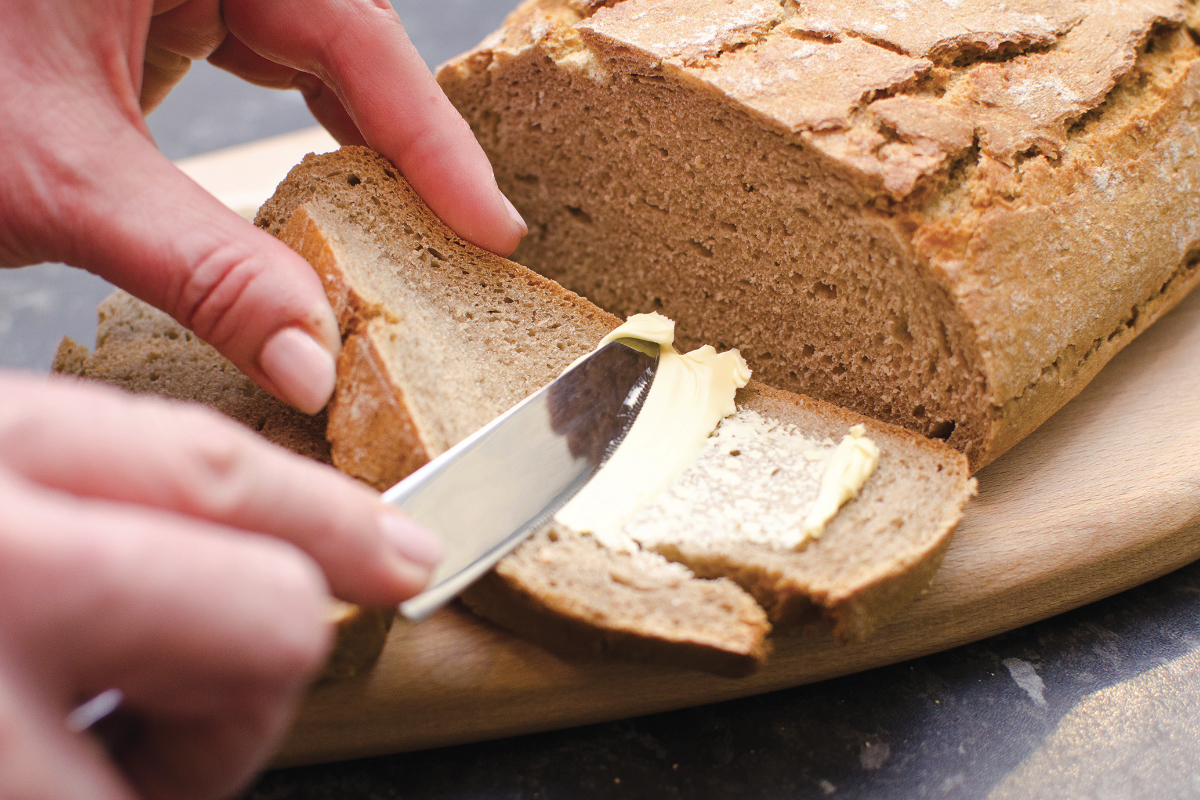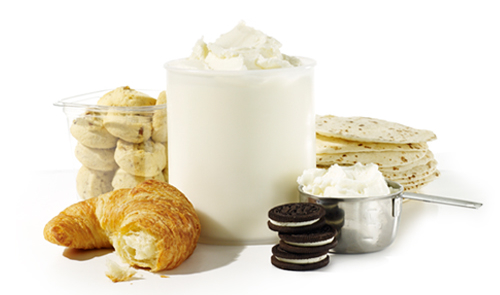KANSAS CITY — Bakers have been trying to remove partially hydrogenated oils (phos) long before the U.S. Food and Drug Administration decided these fats were no longer safe for human consumption.
“In 2003, bakery manufacturers started drastically reducing partially hydrogenated oils in their products due to increased awareness about the potential health risks associated with trans fats,” said Jim Robertson, director of the emulsifier portfolio at Corbion.
But the F.D.A.'s announcement three years ago to revoke the GRAS status of phos kicked the replacements into high gear. Phos, with their flexible melting points and stability, offered a wide range of functionality with little negative impact on taste and texture. That has been difficult to replace.
“While many pho alternatives have proven to be effective, they have not come without recognizable challenges,” Mr. Robertson said.
Palm presents challenges in flavor and color reversion, crystallization as well as sustainability concerns. Polyunsaturated oils have an effect on oxidative stability, color and flavor. Fully saturated oils lack functional properties that make them cold-water dispersible without unsaturated fat components.
“When replacing the phos, the alternatives have to function the same in the products — the same texture, taste and shelf life — so a lot of improvements are made on an ongoing basis,” said Harold Kazier, senior research and development manager for Bunge Loders Croklaan.
Evolution of alternatives
The removal of phos from the food supply has been a long time coming. In 2006, the F.D.A. required that trans fats be included in the Nutrition Facts Panel.
“This served as the true catalyst of change from pho to trans-free options to where we are today,” said Roger Daniels, vice-president of research, development and innovation for Stratas Foods L.L.C.
The initial wave of alternatives sought to reduce trans fats and included solutions based in phos, palm and physical blends of shortening, margarine and oils. When the F.D.A. announced it would be revoking the GRAS status of phos, solutions had grown to include not only palm and blends but also enzymatic interesterified solutions. Today, bakers need shortening and oils that provide the same functionality of phos without the versatile-but-banned oils.
 “Ingredient suppliers met and are meeting this need with a merger of tried-and-true oils, new oils and process innovations,” Mr. Daniels said.
“Ingredient suppliers met and are meeting this need with a merger of tried-and-true oils, new oils and process innovations,” Mr. Daniels said.
Replacing phos has been an intensive process. They have wide ranges of plasticity and temperature tolerances. Bakers had a lot of room for error when working with them whereas most alternatives do not boast such flexible ranges.
When bakers started moving away from phos, they needed solutions that would functionally work in their formulations.
“The first wave was, ‘What can I get by with?’” said Richard Galloway, consultant at Qualisoy.
Over time, those needs may have evolved to include improved processing, organoleptic properties and shelf life.
Time and research revealed a better understanding of these solid and liquid alternatives, said Tom Tiffany, senior technical sales manager for ADM Oils.
“In conjunction with this evolution, bakers have, over time, made adjustments with process temperatures, mixing times and formulation to account for the different functionality of the non-pho alternatives,” he said.
During the long lead-up to the removal of phos, Bunge Loders Croklaan has continuously advanced its alternatives.
“We’ve done a lot to improve texture and color,” Mr. Kazier said. “We’ve also worked with processing, trying to alleviate the temperature and handling tolerances of the shortening. We’ve looked at the saturate reduction in these shortenings by taking the palm oil and blending it with other oils that are lower in saturates.”
As today’s pho alternatives offer better functionality, bakers’ vision for their ingredients have widened. While Columbus Vegetable Oils has developed many new products from palm oil, interesterified oils, blending and animal fats, the company has also taken into consideration demands outside the realm of function.
“These products have further evolved to include other industry concerns and requirements such as to ensure that shortenings are responsibly sourced and sustainable, domestically sourced, non-G.M.O., certified organic, kosher, halal, lower saturated fats or many others,” said Rick Cummisford, director of quality for Columbus Vegetable Oils.
 Clean label is one trend that has rounded out the conversation. In addition to seeking a shortening that delivers function and finished product quality, some bakers want it to be label-friendly. As a part of its Regal line, Cargill’s non-hydrogenated icing shortening checks those boxes with a bright white color achieved without any added whiteners.
Clean label is one trend that has rounded out the conversation. In addition to seeking a shortening that delivers function and finished product quality, some bakers want it to be label-friendly. As a part of its Regal line, Cargill’s non-hydrogenated icing shortening checks those boxes with a bright white color achieved without any added whiteners.
With all eyes on trans fats, the nutritional impact of these alternative shortenings could come under scrutiny, too.
“When you can’t get solid fat from trans fat anymore, you’re going to need more saturated fat in the product,” Mr. Kazier said.
Bakers concerned with the nutrition label may be surprised that the saturate fat level may go up.
“There is a misunderstanding that one could just remove the trans fat and the nutritionals would remain the same with respect to the saturate level. Trans fat was a very functional component to the shortening for structure, melting properties and functionality,” he said. “When you take out the trans fat, you have to replace it with something.”
Reducing that level of saturated fat but maintaining plasticity is often an exercise in blending functional solid fats and less saturated liquid oils.
Bunge Loders Croklaan’s saturate-sparing shortening has not only no trans fat but also up to 50% less saturated fat than traditional palm oil shortenings, according to Mark Stavro, senior director of marketing. Its PhytoBake shortening also offers less saturated fat by replacing it with phytosterols. This allows the shortening to deliver the functional benefits of shortening with reduced saturated fat.
Today’s pho alternatives have branched out to include high-oleic oils and canola, sunflower and other crop bases.
“In recent years, we have seen improved functionality in pho alternatives, such as cleaner aromas and flavors in frying fats, longer shelf life with high-oleic soy oils compared to standard soybean oils, and wider plasticity ranges required for cake icings and laminated doughs,” said Ben Brue, director of dry ingredients at Dawn Foods.
With so many options, bakers can work with suppliers to customize the fat for their products.
The lesson of customization
Probably the most valuable lesson learned in the replacement of phos is that there isn’t a one-size-fits-all solution.
“No single substitute for phos can work in every application, and that shouldn’t be a surprise because there was never one p.h.o.,” Mr. Galloway said.
Phos covered a spectrum of products, from the solid shortenings to pourable frying oils.
 Because fats and oils have a wide range of uses — and phos offer stability and functionality — there are now plenty of alternatives that formulators can tweak to meet exact needs. Whether it’s functionality in the formulation, processing conditions or adjacent concerns such as sourcing and sustainability, bakers have a wealth of options to choose from.
Because fats and oils have a wide range of uses — and phos offer stability and functionality — there are now plenty of alternatives that formulators can tweak to meet exact needs. Whether it’s functionality in the formulation, processing conditions or adjacent concerns such as sourcing and sustainability, bakers have a wealth of options to choose from.
“Every application is a bit different, and some are a bit trickier than others,” Mr. Kazier said, citing laminating fats for puff pastry as one. “The shortening has to be machineable, it has to be fairly temperature tolerant, and it has to handle, and those are the most challenging because phos seem to be more tolerant than the alternatives.”
Bunge Loders Croklaan worked on a shortening for these tricky applications, and it had to meet those high standards. It had to deliver the height and flakiness in a puff pastry while also being plastic enough to be extruded and have a good temperature tolerance.
“It has all of those characteristics that pho fat had,” he said.
Today, bakers can choose shortenings and other fats created from a variety of base oils including canola, coconut, palm, soybean and sunflower. These oils, and their high-oleic counterparts, can be blended together and interesterified to create a custom solution for any application. It’s simply a matter of working with a shortening supplier and communicating needs effectively.
“This is where our co-development approach comes into play,” said Chris Bohm, customer innovation manager of bakery for AAK USA.
With multi-oil capabilities, that adds palm kernel, safflower, and non-G.M.O. soy oils to the previous list, AAK can make shortenings from different components to customize a solution. These components can be fractions or interesterified blends.
Columbus Vegetable Oils also offers hundreds of fats and oils that may be custom blended to meet bakers’ goals.
 “Many of these projects involve not just replacing the now-discontinued pho shortenings but also improving on the quality, performance and stability of finished products as well as the numerous soft aspects of the product such as sustainability, ethical sourcing, non-G.M.O., etc.,” Mr. Cummisford said.
“Many of these projects involve not just replacing the now-discontinued pho shortenings but also improving on the quality, performance and stability of finished products as well as the numerous soft aspects of the product such as sustainability, ethical sourcing, non-G.M.O., etc.,” Mr. Cummisford said.
The company has improved texture or provided a longer shelf life by adjusting the oils in the shortening products it offers.
To find the right shortening replacement, Cargill helps bakers consider the entire ecosystem of the shortening product, including supply chain, procurement practices and finished product qualities like shelf life and eating experience.
“That allows us to give our customers holistic solutions,” said John Satumba, U.S. and Mexico R.&D./technical services for Cargill. “We are now helping some early adopters who maybe didn’t consider the entire ecosystem of their products, and we are now helping those customers reformulate.”
To get ahead of the curve, Corbion started developing and testing non-pho solutions well before the F.D.A. mandated their removal. The company launched its Ensemble emulsifier line at the same time as the announcement and its SweetPro line of emulsifiers soon after.
“These two unique emulsifier lines are specially designed to allow bakery manufacturers to remove phos while ensuring the quality, taste, texture and consistency of their products,” Mr. Robertson said. “With similar handling properties and the same functionality as phos, our non-pho emulsifier solutions allow bakers to select the non-pho fats or oils that work best for their applications.”
High-performance crops and fats
High-oleic oils provide an effective domestic alternative to commodity oils and tropical oils in the pho alternative game. These oils — high-oleic soy, canola and sunflower — are derived from crops that have been bred for more stability. They are high in monosaturates — a.k.a. the “good” fats — and their stability makes them easier to use.
“Since the late 2000s, high-oleic canola and high-oleic soybean oils have been commercialized to meet the demands for applications that demand a highly oxidatively stable oil,” Mr. Tiffany said. “These trait-enhanced oils can be used alone, in blends with palm oil or as the liquid oil component of interesterified shortenings and hard stocks.”
 ADM developed a second generation high-oleic soy-based solid shortening that offers improved functional and oxidative attributes to its earlier soybean oil-based pho alternatives.
ADM developed a second generation high-oleic soy-based solid shortening that offers improved functional and oxidative attributes to its earlier soybean oil-based pho alternatives.
Stratas Foods’ Sweetex Golden Flex cake and icing shortenings use high-oleic soybean oil to create a shortening that cremes faster and takes on water in the mixing bowl faster. It also is plastic at room temperature without drastic responses to major temperature swings.
“If this gets cold, it gets firm but not brittle. If it gets warm, it’s not soup,” said Mitch Riavez, certified master baker and bakery sales manager for Stratas Foods, at Qualisoy’s Joy of Soy Tour in Savannah, Ga.
Bunge Loders Croklaan’s high-oleic options, including soybean and non-G.M.O. sunflower oils, offer shelf stability that is similar to phos. Its high-performance shortenings made with high-oleic soybean oil give more challenging applications such as donuts and icings improved stability and functionality.
Currently high-oleic oils and shortenings derived from them can be pricier than other alternatives. Supply of these crops just isn’t as pervasive as commodity crops. However, that is changing and may have a long-term effect on price.
Molecular rearranging
Enzymatic interesterification offers some exciting opportunities in pho-free shortenings.
“Enzymatically interesterified shortening was really not fully perfected when the trans-fat labeling was enacted and was just being improved when the F.D.A. took their action against phos in 2014-15, so it’s fairly new,” Mr. Galloway said. “It’s very exacting now.”
This process rearranges the fatty acids of triglycerides to change the fat’s attributes, such as melting point and crystallization. By blending two oils, introducing an enzyme and then heating and cooling the blend, formulators can create a shortening with similar functionality to phos, namely a wider range of stability, without any trans fat.
As Mr. Tiffany explained, high-oleic soybean oil and fully hydrogenated soybean oil are blended together and interesterified with the use of enzymes. This creates a soy-based shortening that is non-pho but delivers the melting and oxidative characteristics necessary to serve a wider range of bakery applications.
 “With this development, some of the functionality lost by moving away from phos is regained, thus paving the way for the next generation of soybean oil based non-pho solutions,” he said.
“With this development, some of the functionality lost by moving away from phos is regained, thus paving the way for the next generation of soybean oil based non-pho solutions,” he said.
Stratas Foods’ Flex processing approach creates a wide range of functionality. The company has applied it to several shortenings and margarines in its portfolio, including those based in palm, interesterified soy and interesterified high-oleic soy.
The plasticity and texture of interesterified high-oleic soybean shortening can be beneficial for bakery applications that have found the jump to non-pho shortenings challenging, specifically, puff pastries and buttercream icing, according to Mr. Galloway.
“Applications like puff pastries need those layers to be smooth, not bumpy and rough, and interesterified high-oleic soybean shortening gives really good layering in puff pastry products,” he said. “Buttercream icing and other products that need a smooth consistency, yet pliable workability, can also benefit.”
Mixed to perfection
By blending different kinds of oils and hard fractions, formulators can create shortenings that meet bakers’ needs. This technique allows suppliers to work around the limitations of fats and oils to create something that delivers the stability and functionality of phos.
Solids are the key for functionality.
“In the past, mostly tropical or fully hydrogenated fats were used in the quest to build solids,” Mr. Bohm said. Today, he continued, formulators are turning to liquid oils with lower saturate content combined with trans-free solids to achieve the plasticity bakers need.
 “By taking a specific hard stock and adding a liquid oil component to it at different ratios, and also considering the different fractions that we can get from palm to affect the solid content, we can develop a very strong, unique laminated fat that mirrors its trans fat-containing counterpart,” he explained.
“By taking a specific hard stock and adding a liquid oil component to it at different ratios, and also considering the different fractions that we can get from palm to affect the solid content, we can develop a very strong, unique laminated fat that mirrors its trans fat-containing counterpart,” he explained.
The key to this technique is getting the ratio of solids and liquids just right. Too much solid fat will result in a higher melt point. This creates a finished product with a residual or waxy mouthfeel. Too much liquid oil and the mouthfeel will be slick. Bakers also might see issues with air retention for leavening, cell structure and density reduction, which would be a problem for cake volume and icing functionality, Mr. Bohm said.
AAK’s Cisao line of shortenings are palm-based and not hydrogenated. They are available for specific applications such as icings as well as all-purpose for a variety of applications.
Continued research and improvement of fat sources — exotic and domestic, plant and animal — are leading to more exacting shortening and oil solutions for the baking industry. Today’s pho alternatives are just one chapter in the continuing story of fats and oils.




